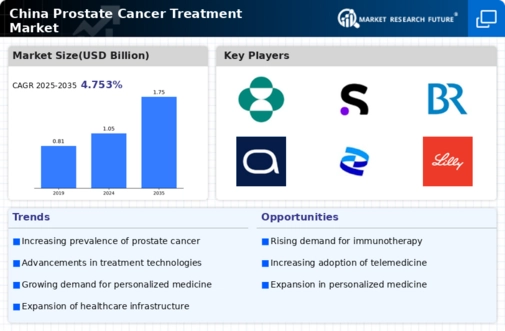Rising Incidence Rates
The prostate cancer-treatment market in China is experiencing growth due to the increasing incidence rates of prostate cancer. Recent statistics indicate that prostate cancer cases have risen significantly, with estimates suggesting that approximately 100,000 new cases are diagnosed annually. This surge in cases necessitates a corresponding increase in treatment options and healthcare resources. As awareness of prostate cancer grows, more individuals are seeking medical attention, thereby driving demand for innovative therapies and interventions. The rising incidence rates not only highlight the need for effective treatment solutions but also create opportunities for pharmaceutical companies and healthcare providers to expand their offerings in the prostate cancer-treatment market.
Growing Aging Population
The demographic shift towards an aging population in China is a significant driver of the prostate cancer-treatment market. As life expectancy increases, the prevalence of age-related diseases, including prostate cancer, is expected to rise. Current projections indicate that by 2030, over 25% of the Chinese population will be aged 60 and above, leading to a higher incidence of prostate cancer. This demographic trend necessitates the development of specialized treatment options tailored to older patients. Healthcare providers are likely to focus on creating comprehensive care plans that address the unique needs of this population, thereby expanding the prostate cancer-treatment market. The aging population presents both challenges and opportunities for healthcare systems.
Increased Awareness and Education
Increased awareness and education regarding prostate cancer are pivotal in shaping the prostate cancer-treatment market in China. Public health campaigns and educational programs are being implemented to inform individuals about the risks and symptoms of prostate cancer. As awareness grows, more men are seeking screening and treatment options, leading to earlier diagnoses and improved outcomes. Recent surveys indicate that awareness levels have increased by approximately 30% over the past five years. This heightened awareness not only drives demand for treatment but also encourages healthcare providers to enhance their services. Consequently, the prostate cancer-treatment market is likely to expand as more individuals become proactive in managing their health.
Advancements in Medical Technology
Technological advancements play a crucial role in shaping the prostate cancer-treatment market in China. Innovations such as robotic-assisted surgeries, targeted therapies, and advanced imaging techniques are revolutionizing treatment approaches. For instance, the adoption of robotic surgery has increased, with hospitals reporting improved patient outcomes and reduced recovery times. Furthermore, the integration of artificial intelligence in diagnostic processes enhances early detection and personalized treatment plans. These technological developments not only improve the efficacy of treatments but also attract investment in research and development, thereby fostering growth in the prostate cancer-treatment market. The continuous evolution of medical technology is likely to enhance patient care and expand treatment options.
Government Initiatives and Funding
Government initiatives aimed at combating cancer are significantly influencing the prostate cancer-treatment market in China. The Chinese government has implemented various policies to enhance cancer care, including increased funding for research and treatment facilities. In recent years, the government allocated over $1 billion to cancer research, which includes prostate cancer. These initiatives aim to improve access to treatment and promote awareness among the population. Additionally, public health campaigns are being launched to educate individuals about prostate cancer risks and the importance of early detection. Such government support is likely to stimulate growth in the prostate cancer-treatment market, as it encourages innovation and improves healthcare infrastructure.























Leave a Comment